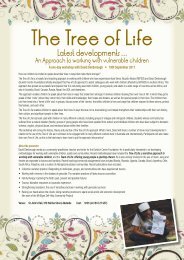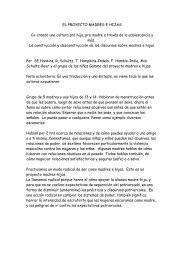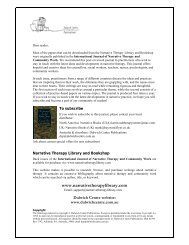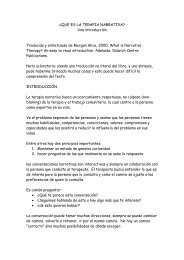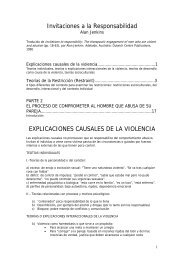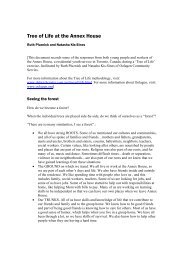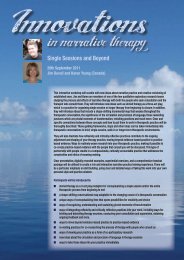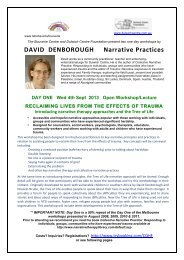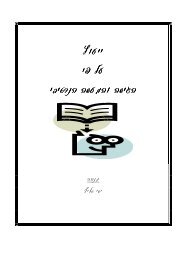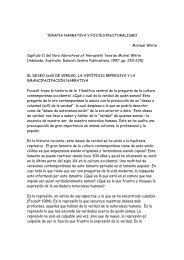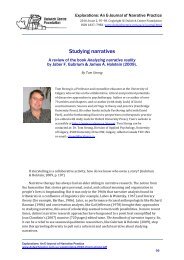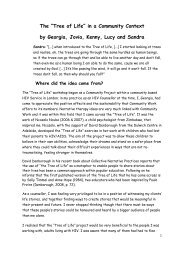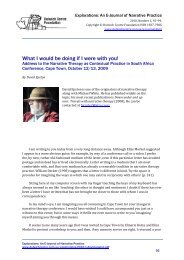Tree of Life in Sundbyberg, Sweden - Dulwich Centre
Tree of Life in Sundbyberg, Sweden - Dulwich Centre
Tree of Life in Sundbyberg, Sweden - Dulwich Centre
You also want an ePaper? Increase the reach of your titles
YUMPU automatically turns print PDFs into web optimized ePapers that Google loves.
<strong>Tree</strong> <strong>of</strong> <strong>Life</strong> <strong>in</strong> <strong>Sundbyberg</strong>, <strong>Sweden</strong>byTorbjörn Vennström, social worker &family therapisttel: +4687068258 torbjorn.vennstrom@sundbyberg.seKari Kamsvåg Magnusson, social worker & family therapisttel: +4687068255 kari.kamsvagmagnusson@sundbyberg.seResursteametIndivid‐ och omsorgsförvaltn<strong>in</strong>gen, <strong>Sundbyberg</strong>s stad, 172 92 <strong>Sundbyberg</strong>, <strong>Sweden</strong>www.sundbyberg.seFor the last two years we have (<strong>in</strong> a small scale) been try<strong>in</strong>g to develop different k<strong>in</strong>ds <strong>of</strong>practice built on the <strong>Tree</strong> <strong>of</strong> <strong>Life</strong> metaphor <strong>in</strong> a Swedish context. In this paper wesummarizes our use <strong>of</strong> <strong>Tree</strong> <strong>of</strong> <strong>Life</strong> and some <strong>of</strong> our experiences.The first time we first got <strong>in</strong> touch with <strong>Tree</strong> <strong>of</strong> <strong>Life</strong> was when we visited the 8 th InternationalNarrative Therapy and Community Work Conference <strong>in</strong> Norway 2007. We were deeplymoved by Ncazelo Ncube‐Mlilo and her story about her work among highly vulnerablechildren <strong>in</strong> Southern Africa. We immediately bought the DVD <strong>Tree</strong> <strong>of</strong> <strong>Life</strong>, which was reallyhelpful <strong>in</strong> understand<strong>in</strong>g how to learn and try out the method, and also teach<strong>in</strong>g it to others.Who are we?We work as family counselors <strong>in</strong> a municipality based service <strong>in</strong> a small suburb called<strong>Sundbyberg</strong> close to Stockholm, <strong>Sweden</strong>. We work with family therapy oriented approachesto support families, parents and young people to take on challenges <strong>in</strong> their relationshipsand life circumstances. Part time we also <strong>of</strong>fer group oriented methods for parents andchildren. In that context we became <strong>in</strong>terested <strong>in</strong> us<strong>in</strong>g <strong>Tree</strong> <strong>of</strong> <strong>Life</strong> to facilitate rich identitynarratives that enhance the participants self esteem and cop<strong>in</strong>g abilities.How we got go<strong>in</strong>g.All the articles about <strong>Tree</strong> <strong>of</strong> <strong>Life</strong> experiences that are published on <strong>Dulwich</strong> <strong>Centre</strong> Websitewere very useful <strong>in</strong> gett<strong>in</strong>g ideas about different ways <strong>of</strong> explor<strong>in</strong>g the method. We startedout with translat<strong>in</strong>g and putt<strong>in</strong>g together a short guidel<strong>in</strong>e <strong>in</strong> Swedish. At that time wemostly had <strong>in</strong> m<strong>in</strong>d to work with a group <strong>of</strong> children <strong>in</strong> age 8 – 12 years.
Project for children <strong>of</strong> refuges and immigrantsThe news about <strong>Tree</strong> <strong>of</strong> <strong>Life</strong> spread <strong>in</strong> the surround<strong>in</strong>gs. We were contacted by a schoolnurse responsible for the children <strong>of</strong> the refuges and new immigrants <strong>in</strong> <strong>Sundbyberg</strong>. Aproject between the social workers, help<strong>in</strong>g the grown up immigrants and refuges, and theeducators <strong>of</strong> the children were about to start. The United Nations convention on the rights<strong>of</strong> the child was the focus <strong>of</strong> the project and the aim to see the family as a whole system.This seemed like a very <strong>in</strong>terest<strong>in</strong>g work to us and so the cooperation started. Our part <strong>of</strong>the project was to teach the method to the teachers <strong>of</strong> the <strong>in</strong>troduction classes, socialworkers, language guides and native language teachers. We decided to teach the methodthe same way Ncazelo Ncube‐Mlilo did <strong>in</strong> the DVD <strong>Tree</strong> <strong>of</strong> life, by guid<strong>in</strong>g the staff <strong>in</strong> mak<strong>in</strong>gtheir own trees. Dur<strong>in</strong>g one day they created the trees and made the tell<strong>in</strong>g and retell<strong>in</strong>g <strong>in</strong>groups <strong>of</strong> 4‐6 persons. At the end <strong>of</strong> the day we discussed how to arrange the method <strong>in</strong>school, set dates and staff for the days.Later on we assisted <strong>in</strong> the plann<strong>in</strong>g <strong>of</strong> the <strong>Tree</strong> <strong>of</strong> life days and we supervised the staffdur<strong>in</strong>g the implementation.The children <strong>of</strong> the <strong>in</strong>troduction classes are divided <strong>in</strong>to three groups, 7‐12 years, 12‐16years and 16‐19 years. The <strong>in</strong>troduction groups have conducted the <strong>Tree</strong> <strong>of</strong> life‐project twotimes each, totally <strong>in</strong> six groups. And this spr<strong>in</strong>g we are <strong>in</strong>troduc<strong>in</strong>g <strong>Tree</strong> <strong>of</strong> life <strong>in</strong> three newgroups. Teachers, language guides, social workers and native language teachers haveworked side‐by‐side <strong>in</strong> help<strong>in</strong>g the children mak<strong>in</strong>g their trees, tell<strong>in</strong>g their story, comfort achild when needed, listened and supported the dreams and hopes <strong>of</strong> the children and f<strong>in</strong>allycelebrat<strong>in</strong>g together.The people <strong>in</strong>volved <strong>in</strong> the project have met and summoned the work<strong>in</strong>g together two timesand we are now look<strong>in</strong>g forward to spend<strong>in</strong>g a narrative day together <strong>in</strong> April. We have<strong>in</strong>vited a therapist for a lecture <strong>in</strong> narrative theory to deepen the understand<strong>in</strong>g <strong>of</strong> thenarrative approach.What have we learned?So is this a helpful method for children <strong>in</strong> our context? We th<strong>in</strong>k so. In the evaluations thechildren br<strong>in</strong>gs out various values from the days:About loss and love; ”I have lost everyth<strong>in</strong>g. This is mynew tree, my new life”.About roots, dreams and help<strong>in</strong>g others; ”We have donea good job together. Say<strong>in</strong>g nice th<strong>in</strong>gs to each other,makes you feel happy. When I did my roots I thought a lotabout my grand mother. It was fantastic! Yesterday I hada dream, that I would go back to my country and do <strong>Tree</strong><strong>of</strong> <strong>Life</strong> with the children <strong>of</strong> my country. In my countrymany children suffer. I th<strong>in</strong>k they would be helped bydo<strong>in</strong>g <strong>Tree</strong> <strong>of</strong> <strong>Life</strong>.”About feel<strong>in</strong>g good; ”When I feel sad I can th<strong>in</strong>k about thenice words we told each other and I will forget about thebad.”
The staff <strong>of</strong> the school project described deepened relations with the children. Know<strong>in</strong>gabout the history and about the child´s way <strong>of</strong> coop<strong>in</strong>g made a difference <strong>in</strong> future work.One <strong>of</strong> the language guides sent us a mail; “From my own experience as a refuge I feel howimportant it is that someone is <strong>in</strong>terested <strong>in</strong> me and my roots. I am sure the pupils felt thesame. I have noticed that the self‐esteem <strong>of</strong> the child I was help<strong>in</strong>g, has enhanced. He is moremotivated and he seems more relieved and happy.”The mix <strong>of</strong> the staff (socialworkers and schoolworkers) helped to widen the understand<strong>in</strong>g <strong>of</strong>the whole system, focus<strong>in</strong>g on the child. The socialworkers found a way to meet and create arelation with the child. In the future they are plann<strong>in</strong>g to have common meet<strong>in</strong>gs with theparents and teachers at school. The teachers are discuss<strong>in</strong>g how to <strong>in</strong>vite parents to schooland how to create a good context for meet<strong>in</strong>g the families.Our own learn<strong>in</strong>gWe started out with a method we took to ourhearts by listen<strong>in</strong>g to Ncazelo Ncube‐Mlilo,watch<strong>in</strong>g the DVD and discuss<strong>in</strong>g together. Weare both attracted to the narrative approach <strong>in</strong>meet<strong>in</strong>g with people and difficulties, and eager t<strong>of</strong><strong>in</strong>d ways to <strong>in</strong>tegrate the narrative ways <strong>in</strong> ourwork with children, parents and their socialnetworks.We have found various ways <strong>of</strong> us<strong>in</strong>g <strong>Tree</strong> <strong>of</strong> <strong>Life</strong><strong>in</strong> our context and the develop<strong>in</strong>g process willcont<strong>in</strong>ue. One dream is to develop <strong>Tree</strong> <strong>of</strong> <strong>Life</strong>with a group <strong>of</strong> parents and children together. We are also anxious to use the method <strong>in</strong> ourord<strong>in</strong>ary family therapy work.We would like to notice some <strong>of</strong> the th<strong>in</strong>gs we have learned dur<strong>in</strong>g the process;We learned the importance <strong>of</strong> cohesive days. The children need a good structure andguidance over the days. Splitt<strong>in</strong>g up the work <strong>in</strong> shorter meet<strong>in</strong>gs for a full week wasnot helpful for the children, neither was the change between the <strong>Tree</strong> <strong>of</strong> <strong>Life</strong> work<strong>in</strong>side school and the ord<strong>in</strong>ary brakes <strong>in</strong> the school ground. Many <strong>of</strong> the high schoolstudents appreciated mak<strong>in</strong>g the <strong>Tree</strong> <strong>of</strong> <strong>Life</strong> <strong>in</strong> a different location.The importance <strong>of</strong> br<strong>in</strong>g<strong>in</strong>g the work <strong>of</strong> the children, with struggles, strengths, hopesand dreams, to the context <strong>of</strong> the child. We th<strong>in</strong>k the child needs support to hold onto his or her dreams from the family and other people surround<strong>in</strong>g the child such asteachers, friends etc.By try<strong>in</strong>g <strong>in</strong> various ways we have learned that to understand the method the childneeds some reflect<strong>in</strong>g reflection <strong>in</strong> the method. For younger kids you need to adjustthe approach <strong>in</strong> order to f<strong>in</strong>d a “language” that works. skills. We have learned thatfrom the age <strong>of</strong> 9 year most children can assimilate the levels <strong>of</strong>
The difficulties <strong>in</strong> guid<strong>in</strong>g the children <strong>in</strong> the tell<strong>in</strong>g and re‐tell<strong>in</strong>g position. We bothstruggled with the ”<strong>in</strong>terview<strong>in</strong>g” and had the same reflections from the staff <strong>of</strong> theschool project.All though we felt like beg<strong>in</strong>ners <strong>in</strong> explor<strong>in</strong>g the full body <strong>of</strong> possibilities that lay with<strong>in</strong> <strong>Tree</strong><strong>of</strong> <strong>Life</strong>, we decided to lead a short sem<strong>in</strong>ar on that topic at The Swedish Family TherapyConference <strong>in</strong> Umeå, <strong>Sweden</strong> <strong>in</strong> September 2010. We just wanted to share our experiencesand perhaps to br<strong>in</strong>g more attention to narrative approaches <strong>in</strong> our field <strong>in</strong> <strong>Sweden</strong>. Basedon the sem<strong>in</strong>ar we also published an article about our experiences on <strong>Tree</strong> <strong>of</strong> <strong>Life</strong> <strong>in</strong> a localmagaz<strong>in</strong>e for members <strong>in</strong> The Association for Family and Systemic Oriented Therapy <strong>in</strong>Stockholm.The response was greater than we expected. There have been quite a number <strong>of</strong> colleagueswho wants to know more and discuss how they can use <strong>Tree</strong> <strong>of</strong> life <strong>in</strong> their context. This isreally fun but also a bit scary. We don’t feel like “experts” on narrative approaches or <strong>Tree</strong> <strong>of</strong><strong>Life</strong>. We need to grasp the fundamental and rich ideas <strong>of</strong> this approach and also to get morepractice <strong>in</strong> conversations that facilitate richer and strengthen<strong>in</strong>g identity understand<strong>in</strong>gs. Inorder to make this possible we are connect<strong>in</strong>g with therapists and others who have studiedand practiced narrative approaches <strong>in</strong> our region. Our aim is to be part <strong>of</strong> a supportivenetwork with shared visions on develop<strong>in</strong>g narrative approaches that fit our contexts.



